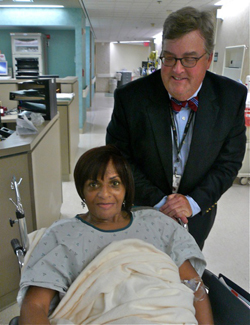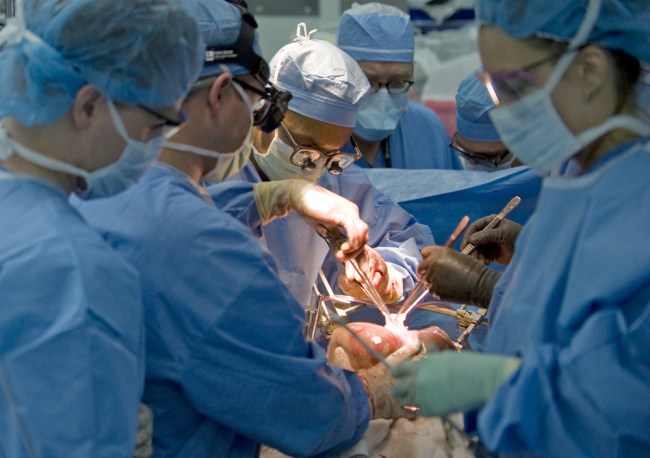
Vanderbilt’s Liver Transplant Program performed its 1,000th transplant earlier this week. (photo by Joe Howell)
Liver transplant program reaches new milestone
With urgency dictating a predawn start, a 12-member team comprised of surgeons, anesthesiologists, nurses and technicians performed Vanderbilt University Medical Center's 1,000th liver transplant on Sunday.
The patient for this historic five-hour procedure was Sharon Byrd, 54, a retired postal worker from Clarksville, Tenn.

J. Kelly Wright Jr., M.D., talks with patient Sharon Byrd before her surgery. (photo by Judy Wright)
This milestone for Vanderbilt's Liver Transplant Program was achieved less than 19 years since the program performed its first transplant in February 1991. The program has averaged performing more than 80 transplants per year during each of the past four years, and is on pace to perform more than 100 transplants this year, so far transplanting 67 adults and five children.
Formed in 1990 by Wright Pinson, M.D., M.B.A., Vanderbilt's deputy vice chancellor for Health Affairs, senior associate dean for Clinical Affairs and director of the Vanderbilt Transplant Center, the Liver Transplant Program has evolved into one of the nation's leading programs in terms of both transplant volume and patient survival rates.
“I am proud and thrilled about our team reaching this milestone in the program's history,” Pinson said. “It is a long way from the start of the program in terms of time, experience, knowledge, surgical technique, and immunosuppression. I can remember our team training in the laboratory nearly 20 years ago. It is interesting that so many of our team has endured to this day.”
Surgeons transplanted the donor liver into Byrd via a carefully choreographed process that has been refined over the years to significantly reduce operative times. The healthy new liver was transplanted from a Tennessee donor.
“This may be the 1,000th liver we've transplanted, but in terms of the donors, they are all equally important to us,” said J. Kelly Wright Jr., M.D., surgical director for the Liver Transplant Program and chief of the Division of Hepatobiliary Surgery and Liver Transplantation.

The surgical team performs Vanderbilt’s 1,000th liver transplant earlier this week, on patient Sharon Byrd. (photo by Joe Howell)
Wright said the milestone is a reflection of the continued support the Liver Transplant Program has received from the Medical Center, the efforts of its dedicated faculty and staff and the trust of referring physicians to send patients to Vanderbilt.
“It's a wonderful experience to be able to continue to be able to do this on a regular basis,” he said.
It was in the very same operating room 19 years ago that Vanderbilt's first liver transplant took place.
“We've tried to maintain things on an even keel, with steady, measured adjustments as we've progressed through new technology and new information that has let us refine our techniques,” Wright said. “We have had excellent luck at this institution with steady support of staff who are dedicated and space given to us to do this work, as we sometimes interrupt the flow of scheduled surgeries.”
As a U.S. military veteran, Byrd's transplant — along with about 300 others at Vanderbilt — was funded by the Veterans Administration. The Nashville VA and VUMC have had a cooperative arrangement to transplant VA patients since 1993 and is one of only five national sites for VA liver transplantation.
Wright said over the years Vanderbilt's surgeons have learned to streamline the process of liver transplantation though the implementation of new surgical techniques and the use of new instrumentation. In earlier years liver transplantation was more resource-intensive.
Operations typically lasted eight to 10 hours. In the early 1990s patients typically spent 14 days in hospital post-transplant versus a typical stay of four or five days now.
“Our program appears to be growing. We have new staff who are young and eager, we have very good ongoing senior staff and we have a good network of patient referrals,” he said.
“So the growth of our program is really tied to donor organ availability. How many transplants we do is really totally dependent on how many healthy organs we can get to put into those patients who are waiting.
“We have many more patients waiting on our list than we have available organs. The answer to further growth for all of our transplant programs lies with getting more people to sign their organ donor cards and getting more families of loves ones to donate organs,” Wright said.
Byrd's medical management pre- and post-transplant has been provided by Joseph Awad, M.D., associate professor of Medicine and Pharmacology.
The team for the 1,000th liver transplant included: Wright; Burnett “Beau” Kelly Jr., M.D., assistant professor of Surgery and surgical director of Pediatric Liver Transplantation; Derek Moore, M.D., assistant professor of Surgery; William Beck, M.D., resident L-1 in General Surgery; William Furman, M.D., professor and vice chair for clinical affairs in the Department of Anesthesiology; Robert Isaak, D.O., resident CA-2 in Anesthesiology; Josh French, technician, Anesthesiology; Karen Ferris, R.N.; Lance Powell, nurse extern; Graham Pollock, VUMS-IV; Lupe Ramirez, surgical technologist and Amber Wallace, surgical technologist.













